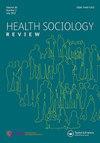我们不是怪物 … 有时候我们真的很难过:隐藏的自我伤害、耻辱和寻求帮助
IF 2.5
2区 医学
Q2 HEALTH POLICY & SERVICES
引用次数: 35
摘要
摘要:本文的目的是提供一个内部视角,了解那些从事隐性自我伤害的人的污名化经历。绝大多数自伤都被认为是隐藏的,因此大多数自伤者都没有接受正规的医疗服务。通过利用在社区环境中与有自伤史的咨询客户和有自伤经验的咨询师进行的20次面对面访谈的数据,我试图深入了解隐藏的自伤、污名和寻求帮助。通过基础理论分析,确定了三类:(1)污名和拒绝;(2) 恐惧和救援的必要性;以及(3)隐秘的羞耻感和自我羞辱。每个类别相互关联,形成了核心类别,“污名渗透到自残者的生活中。”我的研究表明,围绕自我伤害的社会污名与自我污名相互作用,并加剧了现有的羞耻感,从而限制了寻求帮助和康复。服务提供者和决策者需要意识到耻辱的各种表现形式,这些表现形式加剧了自伤对人们生活的破坏性影响。本文章由计算机程序翻译,如有差异,请以英文原文为准。
‘We’re not monsters … we’re just really sad sometimes:’ hidden self-injury, stigma and help-seeking
ABSTRACT The aim of this article is to provide an insider perspective on experiences of stigmatisation for people who engage in hidden self-injury. The vast majority of self-injury is recognised to be hidden, whereby most people who self-injure do not present to formal health services. By drawing on the data from 20 face-to-face interviews, conducted in community settings, with counselling clients with a history of self-injury and counsellors experienced in working with self-injury, I sought to provide insights into hidden self-injury, stigma and help-seeking. Through a Grounded Theory analysis, three categories were identified: (1) stigma and rejection; (2) fear and the need to rescue; and, (3) secret shame and self-stigma. Each category inter-relates to form the core category, ‘stigma permeates the lives of people who self-injure.’ My research demonstrates that social stigma surrounding self-injury interacts with self-stigma and compounds existent feelings of shame, thus restricting help-seeking and recovery. There is a need for service-providers and policy-makers to become aware of the multifarious manifestations of stigma, which reinforce the devastating impact of self-injury on people’s lives.
求助全文
通过发布文献求助,成功后即可免费获取论文全文。
去求助
来源期刊

Health Sociology Review
Multiple-
CiteScore
7.50
自引率
0.00%
发文量
14
期刊介绍:
An international, scholarly peer-reviewed journal, Health Sociology Review explores the contribution of sociology and sociological research methods to understanding health and illness; to health policy, promotion and practice; and to equity, social justice, social policy and social work. Health Sociology Review is published in association with The Australian Sociological Association (TASA) under the editorship of Eileen Willis. Health Sociology Review publishes original theoretical and research articles, literature reviews, special issues, symposia, commentaries and book reviews.
 求助内容:
求助内容: 应助结果提醒方式:
应助结果提醒方式:


